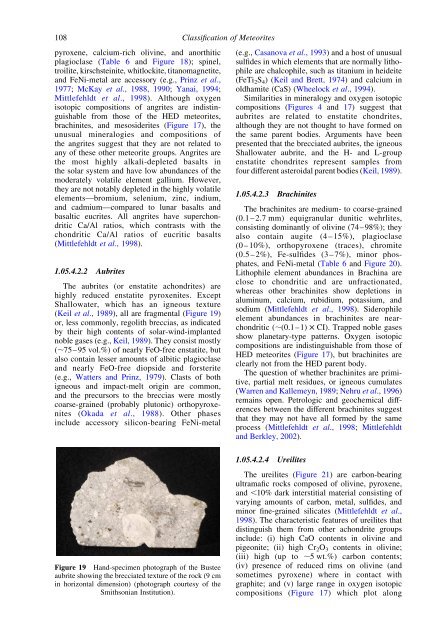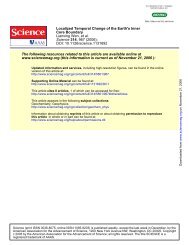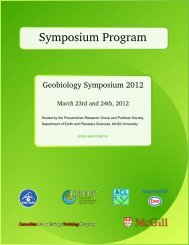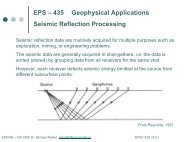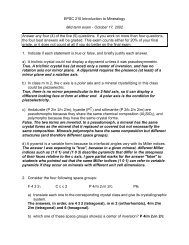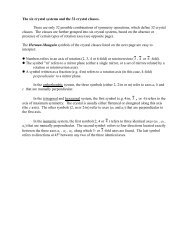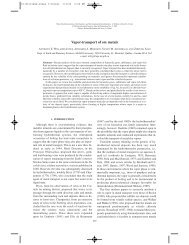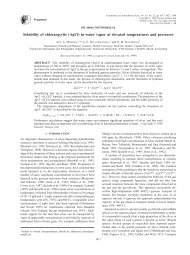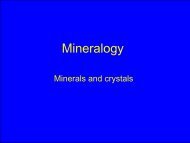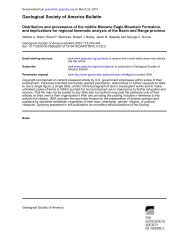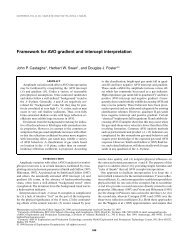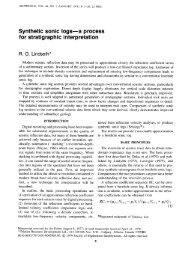05 Classification of.. - Department of Earth and Planetary Sciences
05 Classification of.. - Department of Earth and Planetary Sciences
05 Classification of.. - Department of Earth and Planetary Sciences
You also want an ePaper? Increase the reach of your titles
YUMPU automatically turns print PDFs into web optimized ePapers that Google loves.
108<br />
pyroxene, calcium-rich olivine, <strong>and</strong> anorthitic<br />
plagioclase (Table 6 <strong>and</strong> Figure 18); spinel,<br />
troilite, kirschsteinite, whitlockite, titanomagnetite,<br />
<strong>and</strong> FeNi-metal are accessory (e.g., Prinz et al.,<br />
1977; McKay et al., 1988, 1990; Yanai, 1994;<br />
Mittlefehldt et al., 1998). Although oxygen<br />
isotopic compositions <strong>of</strong> angrites are indistinguishable<br />
from those <strong>of</strong> the HED meteorites,<br />
brachinites, <strong>and</strong> mesosiderites (Figure 17), the<br />
unusual mineralogies <strong>and</strong> compositions <strong>of</strong><br />
the angrites suggest that they are not related to<br />
any <strong>of</strong> these other meteorite groups. Angrites are<br />
the most highly alkali-depleted basalts in<br />
the solar system <strong>and</strong> have low abundances <strong>of</strong> the<br />
moderately volatile element gallium. However,<br />
they are not notably depleted in the highly volatile<br />
elements—bromium, selenium, zinc, indium,<br />
<strong>and</strong> cadmium—compared to lunar basalts <strong>and</strong><br />
basaltic eucrites. All angrites have superchondritic<br />
Ca/Al ratios, which contrasts with the<br />
chondritic Ca/Al ratios <strong>of</strong> eucritic basalts<br />
(Mittlefehldt et al., 1998).<br />
1.<strong>05</strong>.4.2.2 Aubrites<br />
The aubrites (or enstatite achondrites) are<br />
highly reduced enstatite pyroxenites. Except<br />
Shallowater, which has an igneous texture<br />
(Keil et al., 1989), all are fragmental (Figure 19)<br />
or, less commonly, regolith breccias, as indicated<br />
by their high contents <strong>of</strong> solar-wind-implanted<br />
noble gases (e.g., Keil, 1989). They consist mostly<br />
(,75–95 vol.%) <strong>of</strong> nearly FeO-free enstatite, but<br />
also contain lesser amounts <strong>of</strong> albitic plagioclase<br />
<strong>and</strong> nearly FeO-free diopside <strong>and</strong> forsterite<br />
(e.g., Watters <strong>and</strong> Prinz, 1979). Clasts <strong>of</strong> both<br />
igneous <strong>and</strong> impact-melt origin are common,<br />
<strong>and</strong> the precursors to the breccias were mostly<br />
coarse-grained (probably plutonic) orthopyroxenites<br />
(Okada et al., 1988). Other phases<br />
include accessory silicon-bearing FeNi-metal<br />
<strong>Classification</strong> <strong>of</strong> Meteorites<br />
(e.g., Casanova et al., 1993) <strong>and</strong> a host <strong>of</strong> unusual<br />
sulfides in which elements that are normally lithophile<br />
are chalcophile, such as titanium in heideite<br />
(FeTi 2 S 4 )(Keil <strong>and</strong> Brett, 1974) <strong>and</strong> calcium in<br />
oldhamite (CaS) (Wheelock et al., 1994).<br />
Similarities in mineralogy <strong>and</strong> oxygen isotopic<br />
compositions (Figures 4 <strong>and</strong> 17) suggest that<br />
aubrites are related to enstatite chondrites,<br />
although they are not thought to have formed on<br />
the same parent bodies. Arguments have been<br />
presented that the brecciated aubrites, the igneous<br />
Shallowater aubrite, <strong>and</strong> the H- <strong>and</strong> L-group<br />
enstatite chondrites represent samples from<br />
four different asteroidal parent bodies (Keil, 1989).<br />
1.<strong>05</strong>.4.2.3 Brachinites<br />
The brachinites are medium- to coarse-grained<br />
(0.1–2.7 mm) equigranular dunitic wehrlites,<br />
consisting dominantly <strong>of</strong> olivine (74–98%); they<br />
also contain augite (4–15%), plagioclase<br />
(0–10%), orthopyroxene (traces), chromite<br />
(0.5–2%), Fe-sulfides (3–7%), minor phosphates,<br />
<strong>and</strong> FeNi-metal (Table 6 <strong>and</strong> Figure 20).<br />
Lithophile element abundances in Brachina are<br />
close to chondritic <strong>and</strong> are unfractionated,<br />
whereas other brachinites show depletions in<br />
aluminum, calcium, rubidium, potassium, <strong>and</strong><br />
sodium (Mittlefehldt et al., 1998). Siderophile<br />
element abundances in brachinites are nearchondritic<br />
(,(0.1–1) £ CI). Trapped noble gases<br />
show planetary-type patterns. Oxygen isotopic<br />
compositions are indistinguishable from those <strong>of</strong><br />
HED meteorites (Figure 17), but brachinites are<br />
clearly not from the HED parent body.<br />
The question <strong>of</strong> whether brachinites are primitive,<br />
partial melt residues, or igneous cumulates<br />
(Warren <strong>and</strong> Kallemeyn, 1989; Nehru et al., 1996)<br />
remains open. Petrologic <strong>and</strong> geochemical differences<br />
between the different brachinites suggest<br />
that they may not have all formed by the same<br />
process (Mittlefehldt et al., 1998; Mittlefehldt<br />
<strong>and</strong> Berkley, 2002).<br />
Figure 19 H<strong>and</strong>-specimen photograph <strong>of</strong> the Bustee<br />
aubrite showing the brecciated texture <strong>of</strong> the rock (9 cm<br />
in horizontal dimension) (photograph courtesy <strong>of</strong> the<br />
Smithsonian Institution).<br />
1.<strong>05</strong>.4.2.4 Ureilites<br />
The ureilites (Figure 21) are carbon-bearing<br />
ultramafic rocks composed <strong>of</strong> olivine, pyroxene,<br />
<strong>and</strong> ,10% dark interstitial material consisting <strong>of</strong><br />
varying amounts <strong>of</strong> carbon, metal, sulfides, <strong>and</strong><br />
minor fine-grained silicates (Mittlefehldt et al.,<br />
1998). The characteristic features <strong>of</strong> ureilites that<br />
distinguish them from other achondrite groups<br />
include: (i) high CaO contents in olivine <strong>and</strong><br />
pigeonite; (ii) high Cr 2 O 3 contents in olivine;<br />
(iii) high (up to ,5 wt.%) carbon contents;<br />
(iv) presence <strong>of</strong> reduced rims on olivine (<strong>and</strong><br />
sometimes pyroxene) where in contact with<br />
graphite; <strong>and</strong> (v) large range in oxygen isotopic<br />
compositions (Figure 17) which plot along


